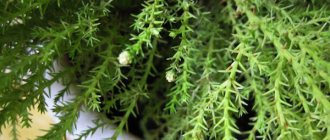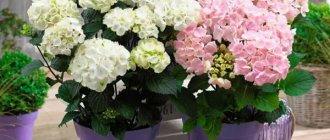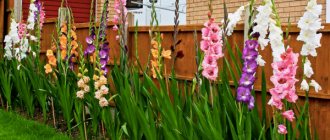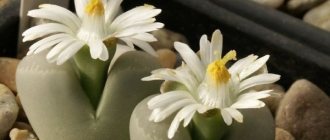With the onset of frost outside, around October, ornamental shrubs and flowering pots begin to prepare for winter, even if they have been growing indoors all year. For many plant species this is a period of dormancy, but for some, on the contrary, in winter they begin to bloom and replace their “summer neighbors” on the window. Despite the transition to a new regime and the slowdown in growth, home flowerpots need to continue to be looked after. Let's consider how to care for indoor plants in winter.
Preparing for winter in the fall
From September to October, the days are shorter, the weather changes, and it becomes colder. From this time on, indoor flowerpots must begin to be switched to winter mode. During the cold season, the vegetative processes of most deciduous plants slow down, and in some they stop altogether. For the winter, deciduous flowerpots are put away in a dark, cool place from the end of autumn, where they wait for spring.
To prevent flowers from experiencing stress from sudden changes in growing conditions and cold, they can be helped to “get ready to relax.” To do this, they stop feeding them, especially with nitrogen-containing fertilizers, water less frequently, moisten them and protect them from drafts.
Plants that need rest for the winter
Most bulbous and all tuberous flowers must go through winter dormancy. In autumn, their leaves naturally turn yellow and fall off or wither; you need to wait for this process and then cut the stems, leaving 2 - 3 cm.
Among the cold-loving ones, flowering ones are distinguished: tuberous begonia, fuchsia, hippeastrum, hydrangea, gloxinia, hyacinths and others.
After pruning, the plant must be treated with solutions of fungicides and insecticides to destroy and prevent diseases, fungi and pests. The roots are then stripped or left in the pot and transferred to a cool, dark place for storage. The temperature is about +5 - +10, and the roots need to be moistened periodically so that they do not dry out. Avoid overwatering, otherwise they will rot and die.
Protect from cooling
With the onset of cold weather, more drafts appear in the apartment, and the temperature on the window sills often becomes 2-3 degrees lower than in the rest of the room. During this period, you should consider options for protecting heat-loving plants from hypothermia.
- The pots are placed in a wooden box, and the free space is filled with sawdust.
- During ventilation, the pots are removed away from windows and doors.
- Avoid contact of leaves with window glass.
- Plants are transferred from unheated balconies inside the apartment, and from window sills they are moved to racks.
How to care for plants on the windowsill in winter?
If the flowerpots do not shed their leaves and continue to turn green in pots, caring for them in cold weather still changes. Changes such as short daylight hours, cold from windows and warm, dry air from heating radiators affect plants, causing them to slow down their development. Caring for them will depend on the type - heat-loving, cold-loving or unpretentious, as well as on the conditions of detention.
Azaleas, indoor roses, poinsettias, Decembrists, cyclamens, guzmans and orchids bloom in winter. Therefore, they require careful treatment, good lighting and watering.
Green shrubs and ornamental trees tolerate cold and cloudy times well, but remain in the room. These include palm trees, aloe, dracaena, cyperus, asparagus, sansevieria, agaves, ivy and ficus.
Succulents and conifers need to be watered rarely when the soil is dry. These include sweatshirt, cactus, boxwood, aloe, milkweed and kalanchoe.
Caring for plants in winter in an apartment also depends on:
- room temperature,
- ventilation frequency,
- type and location of heating devices,
- quality of window structures and air humidity,
- lighting level.
These factors influence how often to water, add light and spray the flowerpots. This is as important as the natural differences between different plant species.
In order for the flowers to survive the winter well and remain healthy, it is necessary to properly care for them.
Humidify the air
As soon as the heating is turned on, it is worth taking care of additional air humidification. What can be done to make the microclimate more suitable:
- Buy a humidifier;
- Using a spray bottle, spray water throughout the room or spray the leaves;
- Place an open container of water next to the pots;
- Combine plants. It has been proven that when placed in groups, air humidity is significantly higher than when placed next to a single flower.
Caring for indoor plants in winter
Let’s look separately at the conditions that need to be created for flowerpots at home during the cold season for successful wintering.
Watering
During winter care, indoor plants need to be watered less than in summer. This is due to the fact that they are in a “sleepy state” and grow slowly, and the temperature of the soil in the pot decreases. Stagnation of water will quickly lead to rotting of the roots and loss of the flower.
Proper watering is carried out rarely, but abundantly. The pot should have a good drainage layer so that excess water flows freely into the tray and is removed. If you water in scanty portions and at long intervals, the earthen ball simply dries out, moisture flows out without moistening it and the roots are not nourished.
Important! On average, flowerpots need to be watered once a week. For this, settled water is used at a temperature slightly above room temperature - 25 - 30 degrees. Cacti don't need to be watered at all.
Humidity
Heating radiators dry out the air, so indoor plants in winter must be frequently sprayed with a spray bottle. If these are flowers with “fluffy” leaves, like gloxinia or violet, they should not be wetted. In this case, you need to spray away from them.
The best way to maintain good humidity in a room with flowers is to turn on a humidifier. The reading on the hygrometer should reach 40-60%.
Lighting
In winter, all plants lack natural sunlight, since daylight hours are very short. The lack of lighting is visible in the state of the flowers themselves. Their stems begin to stretch, the foliage becomes smaller, and the color fades. Flowerpots may not bloom if they are not provided with 14 hours of daylight. Plants with variegated leaves, such as croton, fittonia, heptapleurum, hipestes or arrowroot, with a lack of direct sunlight, darken and lose color.
In order for variegated or flowering indoor plants to grow well in winter, they need to be supplemented with light. To do this, use a special LED phyto-lamp with a violet glow or a regular fluorescent daylight lamp. Provide additional light for 5-6 hours every day and reduce this time as daylight hours lengthen. Place the lamp above the plants at a distance of 60 cm for green ones and 20 - 30 cm for flowering flowerpots.
Leaves must be periodically cleaned of dust. For smooth foliage, use a damp cloth, and for soft foliage, use a warm shower. Dust prevents plants from breathing and drowns out light.
Top dressing
There is no need to feed house flowers in winter. If you want to strengthen the plants during the winter flowering period, the recommended dose should be reduced by 2 times and fertilized no more than once a month.
Add light
Light-loving plants feel especially uncomfortable in the autumn-winter period. Short daylight hours and lack of sunlight often cause wilting or sudden cessation of flowering.
There are several ways to add lighting:
- Place shelves with plants closer to the windows;
- Move the pots to a brighter room.
- Compensate for the lack of sunlight with fluorescent lamps;
In the latter case, it is important not to overdo it with the amount of light. The average length of daylight, sufficient for most plants, is 10-12 hours. If there are enough windows in the room, the backlight should be turned on only for 4-5 hours, as soon as dusk falls.
Maintain a neat appearance
Timely removal of faded buds, washing and polishing of leaf blades not only preserves the external attractiveness of the plant, but also helps it survive a stressful period with minimal losses.
Thus, a dusty coating spoils the appearance of the flower and interferes with normal gas exchange with the external environment. An occasional shower helps flowers breathe, is an excellent means of early detection and removal of pests, and keeps foliage looking healthy.
Despite the fact that the flowering period of most plants occurs in summer and spring, in winter there is no less trouble with them. Each flower requires attention and care, and the strange varieties that came to us from tropical countries are particularly whimsical.
It is important to evaluate your strength, experience and availability of free time for caring for a winter greenhouse before purchasing. If there are not enough temporary resources, it is better to opt for plants that do not require special attention with the onset of cold weather: monstera, ficus, aloe, chlorophytum, etc.
Find a comfortable place
To ensure that the plants have enough light and warmth, you should think about a small rearrangement during the wintering period. Flowers that were hidden in partial shade in summer can be moved closer to the windows, and light-loving crops can be moved from the north and west to the east or south.
When the leaves begin to curl and darken, it is worth finding a warmer place for the pot. A signal of excessively high temperature is the wilting of leaves at the bottom of the stem. You will have to move the pots away from the batteries.
Reproduction
Cuttings
February is a favorable time for propagating plants by cuttings. Cuttings are taken from Araucaria, Sheffera, Aphelandra, Codium, Crossandra, Osmanthus, Stevanotis, Raphiolepis. In order for the cuttings of these plants to take root, soil heating is used.
When propagating araucaria, it is preferable to take the apical cutting from the main trunk. To ensure rooting of cuttings, you can use a stimulator - it will speed up the process of root formation.
For propagation of aphelandra, well-developed leafy but not yet coarsened cuttings are used. Apical cuttings form roots on the twentieth - thirtieth day, and aphelandra stem cuttings form fifty - sixty days.
Raphiolepis and osmanthus are propagated using lignified stem cuttings; roots form in 25–30 days.
Stephanotis is propagated by semi-lignified shoots with at least two internodes, and the leaf blades should be shortened by one third. Young roots of the plant appear in a month.
In February, indoor flowers such as jasmine sambac, begonias, hydrangeas, and clerodendrums require cuttings.
Seeds
Seeds of evergreen begonia, Waller's balsam, and zonal pelargonium are sown for seedlings in February.
Too small begonia seeds are sown with snow. On a light substrate consisting of sand and leaf soil in a ratio (1:3), snow is settled (1 cm layer) and lightly taken.
The seeds are evenly placed on top. Subsequently, the snow will begin to melt and draw the seeds into the substrate. The container with seedlings is placed in a transparent plastic bag and kept in a bright room, darkened from the sun, while the film should not touch the ground. Waller's balsam seeds are germinated in light.
Children will be interested in the idea of planting seeds of exotic fruits - kiwi, avocado, persimmon, date. After germination, entrust the young gardener with the care and maintenance of the plant. This will not only allow the child to learn to love nature, but will also make him responsible and diligent.
Florarium is the best solution for keeping plants in winter
Miniature flowers can be placed in florariums for the winter. Often, ordinary aquariums of various shapes are used for these purposes, since special glass pavilions for indoor flowers are very expensive. Most plants thrive in such conditions not only in the winter season.
A special microclimate creates optimal conditions for flower growth - the absence of drafts, high humidity and stable temperature are liked by most indoor residents. A successfully created composition of various types will become a charming interior decoration.
Miniature plants can be placed in florariums for the winter. © Maia Orjonikidze
Transfer
Gloxinia tubers are planted in a new substrate. For earlier flowering of tuberous begonia, the plant is usually planted at the end of January. Before planting flowers in the soil, you need to place the heavily wrinkled tubers for two to three days in sand or sawdust soaked in a weak solution of potassium permanganate.
In mid-February, tubers of caladiums, amorphophallus, sauromatums (ephemeroids) and rhizomes of koleria are transferred into a new mixture. The substrate for such plants should be slightly moist, but in no case wet (too wet a substrate will cause premature growth).











